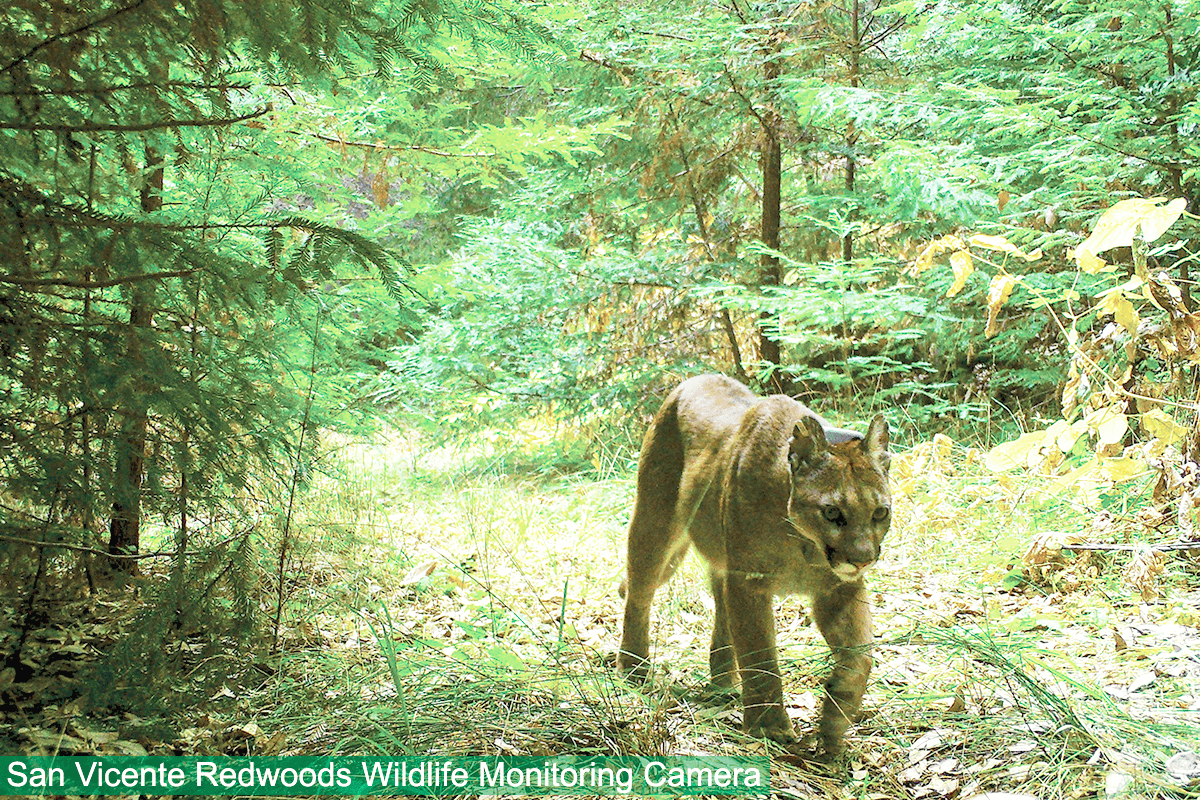SemperVoices: Chris Wilmers On Pumas, People, And The Pandemic
Have you heard about more wildlife sightings since sheltering in place? You’re not alone. Security camera footage of large predators like mountain lions roaming near homes can freak us out. But there’s good news: we should be more afraid of toothbrushes than pumas.
The wild cats of the Bay Area are captivating, and no one knows this better than Chris Wilmers, professor of Wildlife Ecology and Conservation at U.C. Santa Cruz and head of the Santa Cruz Puma Project. After all, he has dedicated his research to these elusive creatures. Chris is currently investigating how humans shape and change wildlife communities in the Santa Cruz mountains. We’re lucky he’s also one of the world-class scientists on our Science Advisory Panel who brings invaluable insights to our work.
Chris leads the Puma Project, which focuses on understanding how humans influence the ecology, conservation, and management of mountain lions (or pumas) in the Santa Cruz mountains. We caught up with Chris to talk about pumas and the potential side effects of altered human behavior during the pandemic.
Are mountain lions dangerous?
“Pumas are perceived to be dangerous, but you are more likely to impale yourself on a toothbrush than to be attacked by a puma. Yet as our feeds are flooded with candid photos from camera traps, there is a growing concern about potential attacks. However, there have only been a handful of attacks in the 150 years of California statehood.”
“you are more likely to impale yourself on a toothbrush than to be attacked by a puma”
Are mountain lions, pumas, and cougars all the same thing?
“Yes, because they have such a large range, people in different areas tend to call them different things, but the scientific name is puma concolor.”
Tell us about your research on mountain lions and people.
“Over at the Puma Project we are investigating how fear of humans drives physiology, behavior, and movement. We have placed cameras at kills and have also set up speakers throughout the forest. When mountain lions heard human voices they adjusted their movement, which cascaded down the food chain to the smaller rodents who switched up their patterns as a result.”
The Anthropause, this period of decreased human activity globally during the pandemic, is getting a lot of attention. What do you think it means for pumas here in the redwoods of the Santa Cruz mountains and mammals around the world?
“Mountain lions fear people and try to avoid us both spatially and temporally. They are more active at night when people are not around. While people get some respite from the city out in nature on the weekends, mountain lions get a break from us during the weekdays and become more active. The full impact will become clearer with time as we gather data as part of a global initiative to look at how mammalian communities are responding to the pandemic, so stay tuned for results from this ongoing study.”
The State of California is considering listing mountain lions as threatened. What does this designation mean for puma habitat?
“Not only would this help the mountain lions in the region, but there is potential to create connections between habitats that can act as wildlife corridors. There has been a lot of work on this locally in the Bay Area by groups like Sempervirens Fund, and there is more that can be done in California as a whole. Corridors are important because mountain lions have a hard time getting from one mountain range to the next. Imagine you are a big cat that needs a wide area to roam, say from the Santa Cruz Mountains to the Mount Diablo range, but there are highways and other human obstacles in between that make it dangerous to get from one place to the next. Corridors join two or more larger areas of similar wildlife habitat and are critical for the movement of animals and the continuation of viable wildlife populations.”
What is the difference between the designation of threatened and endangered species?
“The Endangered Species Act defines an endangered species as, “any species which is in danger of extinction throughout all or a significant portion of its range.” While threatened species are, “any species which is likely to become an endangered species within the foreseeable future throughout all or a significant portion of its range.” Different level of protections are given depending on the classification.”
Why are redwood forests particularly critical for pumas?
“Pumas have the largest latitudinal range of any mammalian species, not including humans. They go where there is deer, natural vegetation, and cover for them to hide on forest floor — all of which the redwoods of the Santa Cruz Mountain range provide, forming an ideal habitat for them to thrive.”
What would you suggest to people who care about mountain lions and local wildlife?
“Stay engaged in local policy to help protect not only pumas but their habitat. National parks, state parks, and protected wilderness areas are a good start, but it is also critical to look at how natural areas tie together to create healthy ecological networks. Support conservation groups like Sempervirens Fund that ensure individual wilderness areas support the whole region and also provide precision protection to effectively preserve the most critical areas to help wildlife survive and thrive.”
How to Help
When you protect and connect enough land for pumas—the mammals with the largest range—you are helping to create a balanced and healthy ecosystem for all plants and wildlife.
- Learn more about Sempervirens Fund’s work to protect puma habitat and the coast redwood forest here.
- If you would like to protect other critical areas for local wildlife habitat, consider donating today.
Sign up for emails from Sempervirens Fund to keep connected with our SemperVoices series.
Published on August 7, 2020



